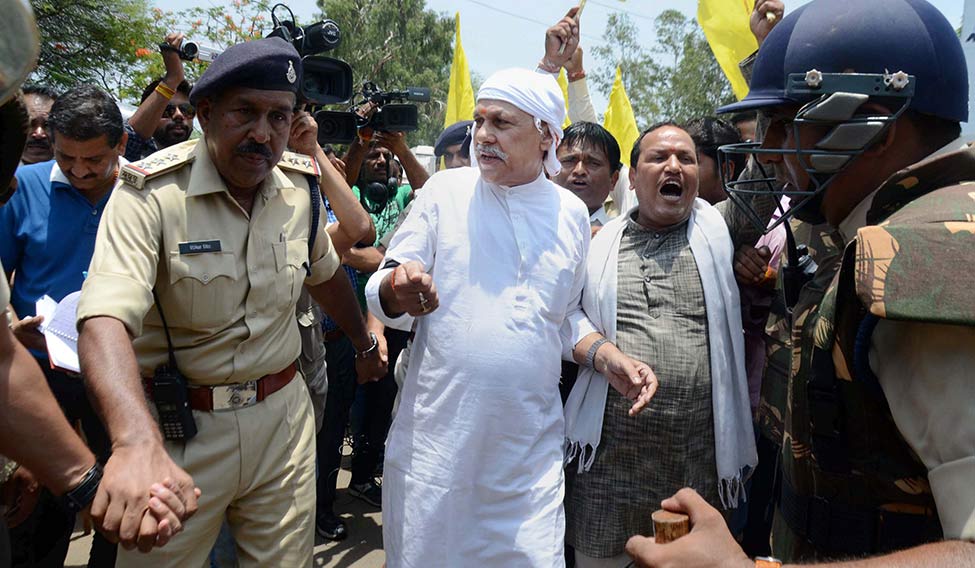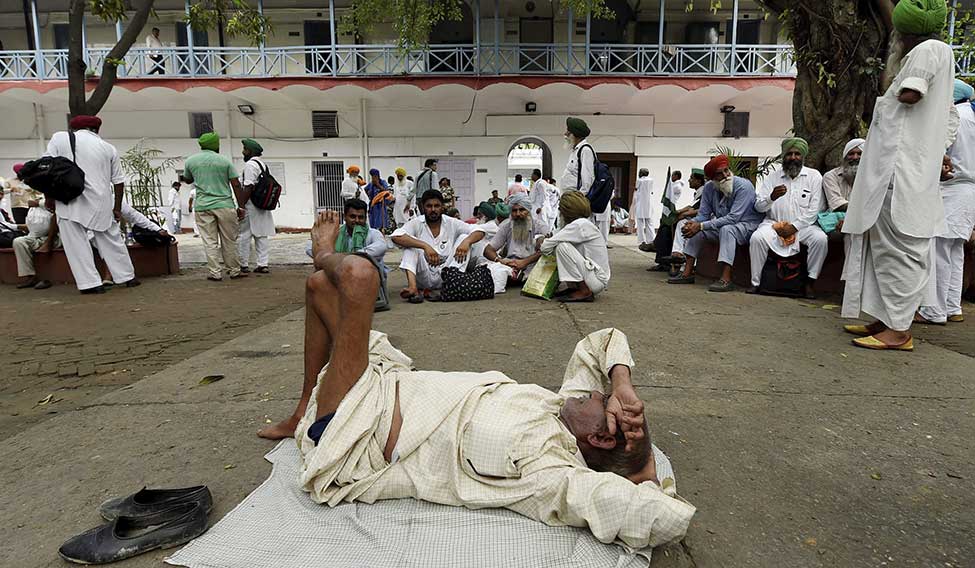Farmers across the country are in distress and are agitated. By announcing farm loan waiver, the governments in Uttar Pradesh, Maharashtra, Punjab and Karnataka have bought themselves peace, at least for now. The relief, however, is temporary. With the rollout of the GST from July 1, farm production cost is expected to rise further. But political considerations seem to weigh heavy on the parties, and chief ministers are forced to implement such costly financial measures. According a recent report by Bank of America Merrill Lynch, if every state were to give a waiver, it would come to Rs 3,00,000 crore, which is 2 per cent of the GDP.
The BJP’s massive victory in Uttar Pradesh was powered by the promise of a loan waiver made by its chief Amit Shah in the party manifesto. And Prime Minister Narendra Modi gave his approval at his first election rally in Meerut on February 4. Within days of assuming office in April, Chief Minister Yogi Adityanath waived off loans to the tune of Rs 36,000 crore, benefitting over 2.36 lakh small and marginal farmers. The actual rollout would be announced in the upcoming state budget.
Fresh from a surprise win in Punjab, Captain Amarinder Singh, too, decided to open up the state coffers for the farmers who helped him secure a victory after two consecutive defeats. On June 19, he announced a waiver that would benefit 8.25 lakh farmers, but it would set the state back by Rs 10,000 crore.
Two days later, Karnataka Chief Minister Siddaramaiah announced a loan waiver of Rs 8,165 crore. In the last assembly elections, the Congress had secured a victory over the B.S. Yeddyurappa-led BJP. With elections due next year, the Congress is doing everything to keep the BJP, which was threatening an agitation on the issue, under check.
Though Maharashtra Chief Minister Devendra Fadnavis had passionately argued against loan waivers—citing the precarious state of finances—once the other states made the announcement, he came under pressure from the agitating farmers and announced a waiver of Rs 34,022 crore on June 24.
Now, farmers in other states are demanding a similar waiver. Five farmers lost their lives in police firing in Mandsaur in Madhya Pradesh. The agitation may put Chief Minister Shivraj Singh Chouhan’s 12-year rule in jeopardy. Farmers in Haryana and Tamil Nadu, too, are holding agitations.
The Uttar Pradesh gamble now stares in the face of the NDA government at the Centre. “Waivers have become fashionable,” said Union minister Venkaiah Naidu, leading to protests from the opposition parties. Union Finance Minister Arun Jaitley left the responsibility of the waivers with the states. “The states will have to do it on their own,” he said. These comments are now likely to haunt the government when the monsoon session begins on July 17, as opposition parties are planning a joint campaign.
 Shiv Kumar Sharma, president of Bharatiya Kisan Mazdoor Mahasangh (being led away by the police during an agitation) | PTI
Shiv Kumar Sharma, president of Bharatiya Kisan Mazdoor Mahasangh (being led away by the police during an agitation) | PTI
“If the opposition parties act smartly, farmers’ issue would be the only way they could halt Modi’s ashwa-medha [winning campaign]. Farmers have that power,” said Raju Shetti, Lok Sabha MP from Maharashtra and president of Swabhimani Shetkari Saghtana, a farmers’ group. An NDA ally, Shetti met Bihar Chief Minister and JDU chief Nitish Kumar on July 1 to seek his support for a joint campaign. “Modiji has the answer for everything, but this issue has left him speechless,” said Shetti.
Ahead of the Lok Sabha elections in 2009, the Congress had announced a mega farm loan waiver scheme, which played a significant role in its victory. Last year, Congress vice president Rahul Gandhi led a delegation that met Modi with a demand for a waiver. The Congress is now holding agitations in Madhya Pradesh, Rajasthan, Haryana, Gujarat and Uttarakhand.
The BJP, on its part, is trying to contain the fallout. “We have started ‘kisan samvaad [dialogue with farmers]’ to listen to their problems and tell them about the initiatives taken by the Modi government,” BJP MP and Kisan Morcha chief Virendra Singh Mast told THE WEEK. Farmers are distressed, said Singh, because they are not getting enough money even after working so hard. “A loan waiver could only be a temporary solution,” said Singh, who has written a letter to Modi and all the chief ministers seeking a permanent solution.
However, Shiv Kumar Sharma, who led the agitation against the Chouhan government in Madhya Pradesh, is not happy with the scale of the waivers announced so far. “The waivers are for small farmers, but bigger farmers are at a greater risk. They are the ones committing suicide,” he said.
Sharma cited a list of 22 decisions taken by the Modi government that has taken its toll on the farmers, like stopping bonus over wheat, reducing duty over import of wheat from 35 per cent to zero, importing toor dal and stopping the export of cotton. According to experts, loan waivers are a waste of the state’s resources as they don’t help the farmers in the long run. “The farm sector faces a debt of about Rs 8 to Rs 10 lakh crore. This is because farmers are not able to get the price they invest,” said noted agriculture economist V.S. Vyas, who was a member of the prime minister’s Economic Advisory Council during the UPA rule, and director of IIM Ahmedabad.
The financial costs of these waivers are heavy. Earlier, states would receive Central allocations based on the expenditure of a specific project or scheme. The 14th Finance Commission changed that and gave the states the freedom to use the Central funds depending on their priorities.
“The states will simply sidestep the issue of Central funding for farm loan waiver,” said development economist Himanshu, who is associate professor at Jawaharlal Nehru University’s Centre for Economic Studies and Planning. “There are two fallouts of this loan waiver which are most detrimental. One, this misguided credit culture will lead to more farm distress. And, second, for the states committing to such schemes, their taxpayers are bound to suffer a dearth of basic facilities in cities.”
According to agriculture economist G.S. Kalkat, providing aid is necessary sometimes, but farmers should be able to increase their income. Eighty per cent of the farmers have less than a hectare so they need to learn more skills to get an additional income.
Meanwhile, the farmers’ unions insist the crisis is not over despite the loan waivers. “Farmers’ issues are not resolved. We are not getting the basic minimum price for most of our produce,” said Ajay Vir Jakhar, chairman of Punjab Farmers Commission and Bharat Krishak Samaj.
The states need to devise a method for better pricing of the farm produce. “Today, a farmer receives a mere one-tenth of the price of his produce,” said Dharmendra Mallick, spokesperson of Bharatiya Kisan Union.
The demonetisation drive has hurt the farmers’ earning prospects. “For taking 0100 in cash payment for farm produce, the discount rate was 10-20 per cent in most mandis,” said Rajasthan Agriculture Minister Prabhulal Saini, himself a farmer. “This was the premium the farmers had to pay for receiving cash payments during demonetisation.”
Apart from increasing productivity, effort needs to be made to contain the input prices. The Centre should help the states, said Vyas. Otherwise Modi’s dream of doubling the farm income by 2022 will remain a dream.
WITH SOUMIK DEY, NIRANJAN TAKLE & DEEPAK TIWARI







